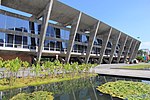Metropolitan Cathedral of St. John the Baptist, NiterĂłi

The Metropolitan Cathedral of St. John the Baptist (Portuguese: Catedral Metropolitana SĂŁo JoĂŁo Batista) Also NiterĂłi Cathedral It is a Catholic cathedral built in late colonial style in the city of NiterĂłi, in the state of Rio de Janeiro in the south of Brazil. It is located in Jardim SĂŁo JoĂŁo, set of landscaped squares in the historical center of the city. It has two bell towers and a rich religious decoration. With the creation of the Royal Ville of Praia Grande, in Niteroi, in 1819, was designed to build a new headquarters at the front of the village. The land was obtained from a donation in 1821 that was received by the Brotherhood of St. John the Baptist, which existed since 1742. In 1831, as the Vicar was Friar Tomaz Aquino, the new cathedral was blessed, for which the Blessed Sacrament was moved and the Images that were in the church of Our Lady of the Conception. It was declared a cathedral in 1908.
Excerpt from the Wikipedia article Metropolitan Cathedral of St. John the Baptist, NiterĂłi (License: CC BY-SA 3.0, Authors, Images).Metropolitan Cathedral of St. John the Baptist, NiterĂłi
Rua BarĂŁo de Amazonas, NiterĂłi Centro (RegiĂŁo Praias da BaĂa)
Geographical coordinates (GPS) Address External links Nearby Places Show on map
Geographical coordinates (GPS)
| Latitude | Longitude |
|---|---|
| N -22.891530555556 ° | E -43.12045 ° |
Address
Catedral SĂŁo JoĂŁo Batista
Rua BarĂŁo de Amazonas
24020-042 NiterĂłi, Centro (RegiĂŁo Praias da BaĂa)
Rio de Janeiro, Brazil
Open on Google Maps







